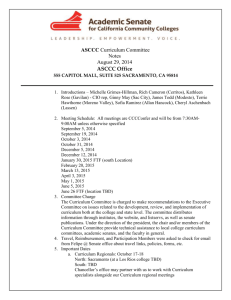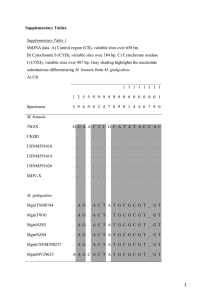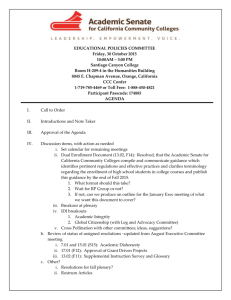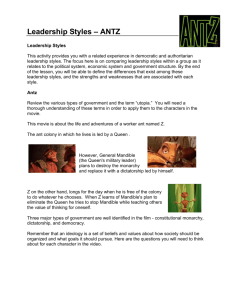.fusk-bearing beaked whales from the ... dimorphism in fossil ziphiids?
advertisement
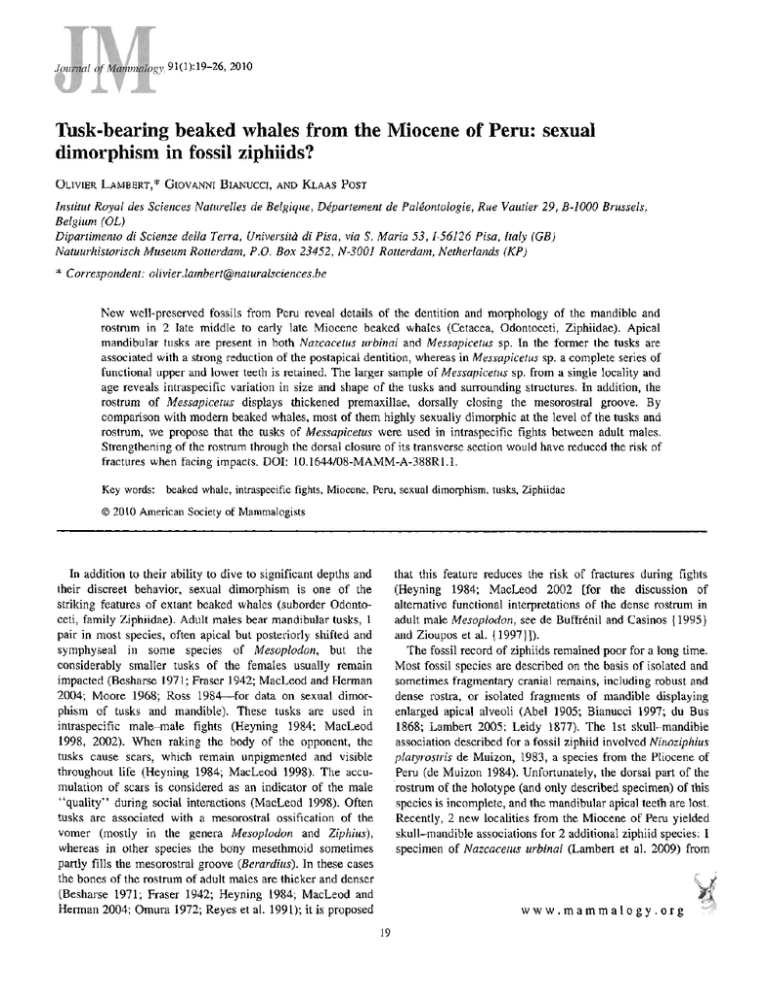
Journal of Mammalogy, 91(6):1313-1321,2010
.fusk-bearing beaked whales from the Miocene of Peru: sexual
dimorphism in fossil ziphiids?
OLIVIER LAMBERT,* GIOVANNI BIANUCCI, AND KLAAS POST
[nstitut Royal des Sciences Naturelles de Belgique, Departement de Pa/eont%gie, Rue Vautier 29, B-1000 Brussels,
Belgium (OL)
Dipartimento di Scienze della Terra, Universita di Pisa, via S. Maria 53, 1-56126 Pisa, Italy (GB)
Natuurhistorisch Museum Rotterdam, P.O. Box 23452, N-3001 Rotterdam, Netherlands (KP)
* Correspondent:
olivier.lambert@naturalsciences.be
New well-preserved fossils from Peru reveal details of the dentition and morphology of the mandible and
rostrum in 2 late middle to early late Miocene beaked whales (Cetacea, Odontoceti, Ziphiidae). Apical
mandibular tusks are present in both Nazcacetus urbinai and Messapicetus sp. In the fonner the tusks are
associated with a strong reduction of the postapical dentition, whereas in Messapicetus sp. a complete series of
functional upper and lower teeth is retained. The larger sample of Messapicetus sp. from a single locality and
age reveals intraspecific variation in size and shape of the tusks and surrounding structures. In addition, the
rostrum of Messapicetus displays thickened premaxillae, dorsally closing the me sorostral groove. By
comparison with modern beaked whales, most of them highly sexually dimorphic at the level of the tusks and
rostrum, we propose that the tusks of Messapicetus were used in intraspecific fights between adult males.
Strengthening of the rostrum through the dorsal closure of its transverse section would have reduced the risk of
fractures when facing impacts. DOl: 10. I 644/08-MAMM-A-388R 1. 1.
Key words:
beaked whale, intraspecific fights, Miocene, Peru, sexual dimorphism, tusks, Ziphiidae
© 2010 American Society of Mammalogists
In addition to their ability to dive to significant depths and
their discreet behavior, sexual dimorphism is one of the
striking features of extant beaked whales (suborder Odontoceti, family Ziphiidae). Adult males bear mandibular tusks, 1
pair in most species, often apical but posteriorly shifted and
symphyseal in some species of Mesoplodon, but the
considerably smaller tusks of the females usually remain
impacted (Besharse 1971; Fraser 1942; MacLeod and Herman
2004; Moore 1968; Ross 1984---for data on sexual dimorphism of tusks and mandible). These tusks are used in
intraspecific male- male fights (Heyning 1984; MacLeod
1998, 2002). When raking the body of the opponent, the
tusks cause scars, which remain unpigmented and visible
throughout life (Heyning 1984; MacLeod 1998). The accumulation of scars is considered as an indicator of the male
"quality" during social interactions (MacLeod 1998). Often
tusks are associated with a mesorostral ossification of the
vomer (mostly in the genera Mesoplodon and Ziphius) ,
whereas in other species the bo"ny mesethmoid sometimes
partly fills the mesorostral groove (Berardius). In these cases
the bones of the rostrum of adult males are thicker and denser
(Besharse 1971; Fraser 1942; Heyning 1984; MacLeod and
Hennan 2004; Omura 1972; Reyes et al. 1991); it is proposed
that this feature reduces the risk of fractures during fights
(Heyning 1984; MacLeod 2002 [for the discussion of
alternative functional interpretations of the dense rostrum in
adult male Mesop/odon , see de Buffrenil and Casinos {1995}
and Zioupos et al. (1997}]).
The fossil record of ziphiids remained poor for a long time.
Most fossil species are described on the basis of isolated and
sometimes fragmentary cranial remains, including robust and
dense rostra, or isolated fragments of mandible displaying
enlarged apical alveoli (Abel 1905; Bianucci 1997; du Bus
1868; Lambert 2005; Leidy 1877). The 1st skull-mandible
association described for a fossil ziphiid involved Ninoziphius
platy/"ostris de Muizon, 1983, a species from the Pliocene of
Peru (de Muizon 1984). Unfortunately, the dorsal part of the
rostrum of the holotype (and only described specimen) of this
species is incomplete, and the mandibular apical teetb are lost.
Recently, 2 new localities from the Miocene of Peru yielded
skull-mandible associations for 2 additional ziphiid species: 1
specimen of Nazcacetus urbinai (Lambert et al. 2009) from
'
r
~
'"
" ",'I
~
www.mammalogy.org
19
'
20
Vol. 91. No. 1
JOURNAL OF MAMMALOGY
FIG. I.-Left lateral view of the skull and associated mandible of Nazcacetus urbina; MUSM 949, Miocene of Peru, with a detail of the apical
enlarged alveolus on the mandible. Scale bar = 100 rom.
Cerro los Quesos, and an exceptional sample of 8 specimens
of a new species of Messapicetus (Bianucci et a1. 1992), 2 of
them with the apical tusks in connection (Lambert et a1. 2008;
O. Lambert, pefs. obs.), from Cerro Colorado. Some rare
modern ziphiid species are known by an even smaller number
of specimens (Dalebout et al. 2002, 2003). In the light of these
new finds we investigate the evolution of tusks, the associated
reinforcement of the rostrum, and sexual dimorphism in
Miocene ziphiids.
Strata from both localities belong to the lower part of the
Pisco Formation, and are dated from late middle to early late
Miocene, roughly between 14 and 10 million years ago
(DeVries 1998; Dunbar et aL 1990). Preliminary phylogenetic
analyses suggest that Messapicetus belongs to the subfamily
Ziphiinae (including the extant species Ziphius cavirostrisBianucci et a1. 1994; Lambert 2005), whereas the affinities of
Nazcacetus are not completely solved. Nevertheless, the latter
is positioned similarly among crown-ziphiids (Lambert et a1.
2009).
MATERIALS AND METHODS
Institutional abbreviations.-MUSM represents the Museo
de Historia Natural, Universidad Nacional Mayor de San
Marco, Lima, Peru; USNM, the United States National
Museum of Natural History, Washington, D.C.; and IRSNB,
the Institut Royal des Sciences Naturelles de Belgique,
Bruxelles, Belgium.
Specimens.-In addition to data from the literature and
specimens from older collections, this work is based mostly on
2 fossil taxa. N urbinai is known from I skull with the
associated mandible and cervical vertebrae (MUSM 949),
found in Cerro los Quesos, 50 km south of the city of lea, on
the coastal desert of southern Peru. Messapicetus sp. is known
from 8 specimens found in Cerro Colorado, 35 km southwest
of lea: MUSM 950 and MUSM 951, fragmentary skulls with
associated mandible elements; MUSM 1036, skull with
associated mandible; MUSM 1037, skull with associated
mandible and tusks; MUSM 1038, skull with associated
mandible and tusk elements; MUSM 1394, fragmentary skull
of a calf; MUSM 1481, skull; and MUSM 1482. anterior
extremity of the rostrum and mandible. This unusually high
concentration of specimens of Messapicetus sp. in a limited
area and roughly the same horizon, including a calf, could
indicate the proximity of a preferential feeding region for this
species (Bianucci et aL 2008a). Because these disarticulated
specimens were found in several beds representing shallowwater deposits and in association with a very diversified
marine fauna (including other cetaceans, turtles, seabirds, and
fishes), the assemblage of Cerro Colorado does not correspond
to a mass-stranding event.
RESULTS
Tusks and surrounding structures on the mandible.--One or
2 pairs of enlarged anterior alveoli often have been reported on
isolated fossil mandibular fragments, generally without tusks
found in situ (Abel 1905; de Muizon 1984; True 1907), except
for a few occasions (e.g., Bianucci 1997; Capellini 1885;
Whitmore and Kaltenbach 2008). The more complete N.
platyrostris and N. urbinai (clearly identified as ziphiids based
on the architecture of the skull, particularly the diagnostic
vertex, the hamular process of the pterygoid, and the periotic)
both display enlarged apical alveoli. confirming that some
fossil ziphiids possessed tusks (de Muizon 1984; Lambert et
a!. 2008, 2009; Fig. 1).
One particularly interesting specimen of Messapicetus sp.
(MUSM 1037) displays a finely preserved pair of complete, in
situ, apical mandibular tusks that are located anterior to the
end of the rostrum and project outside the mouth (Figs. 2 and
3). These teeth have short crowns (9 mm long) and large,
swollen, and transversely flattened roots that have maximum
and minimum diameters (at the level of the alveolus) of 28 and
15 mm. Crowns are straight, not medially curved as in
postapical teeth (see below). Roots are significantly more
robust than roots of postapical teeth (in postapical teeth the
transverse minimum diameter ranges from 5.0 to 11.8 mm, for
a maximum diameter ranging from 8.1 to 26.4 mm). Each
apical tooth is directed anterodorsally, with a slight lateral
inclination. A longitudinal bony crest separates medially left
and right teeth. This crest thickens strongly anteriorly, forming
a robust apical median protuberance, slightly longer than the
LAMBERT ET AL.-MIOCENE TUSK-BEARING BEAKED WHALES
February 2010
21
apical tusks
~~~~I~~~~~~~=~;:re~m~n~a:n~tO~f~m~esorostral
~
groove
fused premaxillae on the rostrum
B
fused premaxillae on the rostrum
alveolar groove
_- L_
-.,..,-~-. ,... ---
~~~=
=
apical tusks
\
FIG. 2.-Skull and associated mandible of Messapicetus sp. MUSM 1037, Miocene of Peru. A) Dorsal view . B) Right lateral view. Scale bar
100 mm.
tusks anteriorly. Posterior to the teeth the longitudinal crest
raises and widens to form the thick anterior margin of a
concave area that fits tightly against the apex of the rostrum. A
similar concavity is observed on the dorsal surface of the
mandible of Z. cavirostris, with the upheaval of the anterior
margin specially developed in adult males (Fig . 4).
In contrast to Nazcacetus, which displays only tiny
postapical teeth likely originally embedded in the gum
(Lambert et al. 2009), functional postapical teeth are retained
in MessapicetHs sp. These teeth show a distinct wear of the
apex (the tips of teeth are regularly truncated, with a flat distal
surface) and anterior- posterior margin of the crown (clear
occlusion grooves), indicating, respectively, contact with food
and opposing teeth. On the mandible these teeth are separated
from apical tusks by a long diastema, as seen in Tasmacetus
shepherdi, the only extant ziphiid retaining functional
postapical teeth. The symphyseal portion of the mandible is
long (38-42% of the mandible length) and robust, with a halfcircular section.
The Peruvian sample for Messapicetus sp. is the 1st for
fossil ziphiids to demonstrate intraspecific variation in the
anterior portion of the mandible (Figs. 5A and 5B). In the
finely preserved MUSM L038 apical alveoli are smaller (23 x
12 mm), the anteromedial bony protuberance is much weaker,
and the upheaval anteriorly limiting the cavity for the rostrum
apex is not as developed as in MUSM 1037. In the more
fragmentarily preserved MUSM 1482 alveoli are much larger
and asymmetric (respectively 18 x 33 and 24 x 35 mm for
~~-::""='---.'- sutural contact between premaxillae
mesorostral groove on the rostrum
thick anterior margin of concave
area for rostrum
crown
apical
tusks
mandible-rostrum boundary
anteromedian protuberance
FIG. 3.-Detail of the anterior end of the mandible and rostrum of Messapicetlls sp. MUSM !O37, Miocene of Peru, displaying apical tusks
and surrounding bony structures. A) Anterior view. B) Lateral (slightly anterior) view.
22
JOURNAL OF MAMMALOGY
USNM 49599
USNM 550148
cf
FIG. 4.-Dorsal view of the anterior part of the mandible of adult
male (USNM 49599, modified from True [1910:plate 23]) and adult
female (USNM 550148) of Ziphius cavirostris. The male bears larger
apical alveoli on a more-robust anterior end of the mandible.
Specimens not to scale; size adjusted for a same symphyseal length.
right and left alveoli) and the anteromedial bony protuberance
is even stronger than in MUSM 1037. The enlargement of the
alveoli in MUSM 1482 further stresses the robustness of the
anterior portion of the mandible, displaying a distinct distal
widening and deepening not as pronounced in MUSM 1037
and absent in MUSM 1038 (Fig. SC).
Rostrum.-Several fossil ziphiid species share with members of the extant genera Mesoplodoll and Ziphius a filling of
the mesorostral groove of the rostrum by the dense vomer (see
Bianucci et al. [2007, 2008b 1 for various species from the
Neogene of South Africa) . Unfortunately, none of these
species is known on the basis of skull-mandible associations.
In N. platyrostris the dorsal part of the rostrum of the holotype
is strongly worn, but no peculiar development of the vomer is
seen . The mesorostral groove of the holotype of N. urbinai is
A
c,
~"
~
c:
"0
Cll
50
40
E
Ql
:5
'0
.r:::
30
20
-'5
.~
hollow-the classical condition in odontocetes other than
ziphiids-and the rostrum is rather slender. This condition
could indicate that this individual was either immature or a
female (Lambert et aL 2009), but a larger sample is needed to
be certain.
Members of the genus Messapicetus are characterized by a
very elongated rostrum, 3 times the length of the cranium
(Bianucci et a1. 1994), proportionally the longest in ziphiids.
In all the specimens of Messapicetus sp. and the Italian species
M. /ongirostris Bianucci et aI., 1992, the groove is not filled by
the vomer; instead it is covered dorsally by a dorsomedial
development of the considerably thickened premaxillae
(Figs. 2 and 6). The premaxillae display a sutural contact for
more than one-half of the rostrum length, the rostrum being
open only dorsally in the more slender anterior portion and in
the prenarial basin. The robust section of the joined
premaxillae is anteriorly half-circular and becomes more
triangular toward the prenarial basin. Sections of the thick
dorsomedially joined premaxillae were illustrated in M.
longirosrris (Bianucci et a1. 1992) and through computed
tomography scans of a fragmentary rostrum from the late
Miocene of Maryland referred to cf. Messapicetus (Fuller and
Godfrey 2007). On the most anterior section provided by
Fuller and Godfrey (2007) the suture between the premaxillae
is nearly invisible, possibly due to the high degree of
ankylosis. Variation in this character among adult specimens
from Cerro Colorado could not be quantified because of the
incompleteness of some specimens and the poorly preserved
rostrum of others. However, the specimen MUSM 1394,
interpreted as a calf (based of the proportionally shorter
rostrum, the partly ossified premaxillary crests on the vertex,
and the presence of distinct parietals on the vertex), bears
distinctly thinner premaxillae on the rostrum. At the posterior
limit of the contact between left and right premaxillae each
bone is 6 mm thick in MUSM 1394 versus 11 mm in the adult
MUSM 951.
A homologous dorsal closure of the mesorostral groove by
premaxillae has been described in several species from late
Miocene-early Pliocene of the North Sea, including Bene-
B
60
Ql
Vol . 91. No. 1
10
~.=:
......
............................................ ..
. .. . .. .. .
. ... ....... .. ..:. :~.:... :.
........................... _.. _................. ...... ........ _.. _......................... ..
-...............
. . ..... .
••••••••••
alveoli
MUSM1482
MUSM 1036
MUSM 1037
MUSM 1038
alv 0 10 20 30 40 50 60 70 80 90
MUSM 1038
MUSM 1037
MUSM 1482
distance posterior to apical alveo lus
FIG. 5.-Variation in size and shape of the anterior part of the mandible in Messapicetus sp. A) Changing width of the mandible from the level
of apical alveoli in 4 specimens (in mm). B) Ventral view of the anterior end of the mandible in 3 specimens, all at the same scale (MUSM 1482
is possibly an adult male). C I) Lateral view of the anterior end of the mandible of MUSM 1482. C2) Dorsal view of the same specimen. Scale bar
== 20 mm.
February 2010
LAMBERT ET AL.-MIOCENE TUSK-BEARING BEAKED WHALES
23
A
sutural med ial contact between premaxillae
B~
=
-------
~-
c tJ
extent of mandibular symphysis
FIG. 6.-A) Reconstruction of the skull and mandible of Messapicetus sp. in lateral view, mostly based on MUSM 1037. except for the
basicranium based on MUSM 1481 . Extent of the symphyseal portion of the mandible and sutural dorsomedial contact of the premaxillae on the
rostrum are indicated by thick lines. Arrows on the apex of the snout symbolize the force exerted on apical tusks during contact with the body of
an opponent and its horizontal and vertical components. B) Section of dorsal portion of rostrum, based on MUSM 1037. Shape and size of the
mesorostral opening at this level are based on computed tomography scan of a rostrum identified as cf. Messapicetl.lS from late Miocene of
Maryland provided by Fuller and Godfrey (2007). C) Section of mandible in the symphyseal portion, based on MUSM 1038. Scale bar =
200 mm.
ziphius brevirostris (Lambert, 2005), Choneziphius planirostris (Cuvier, 1823), and Ziphirostrum marginatum (du Bus,
1868; Fig. 7). In these species premaxillae are even thicker than
in Messapicetus, especially in B. brevirOSlris and C. pianirostris
where the remaining mesorostral canal is nearly completely
occluded. Some variation at the level of the development of the
premaxillae is observed in C. planirostris and Z. marginatum.
For example, Z. marginatum IRSNB M.537 bears much thicker
premaxillae anterior to the prenarial basin than do other
specimens (maximum height of premaxilla on rostrum = 41
versus 17 mm in IRSNB M.1S77), and larger specimens of C.
planirostris have a proportionally deeper rostrum.
DISCUSSION
The most obvious hypothesis for the function of apical
mandibular tusks in Nazcacetus, Ninoziphius, and Messapice-
tus is their use in fights between adult males, as is proposed for
most extant ziphiids. Although fights between adult males
have not been observed, fighting is inferred from the presence
of numerous pairs of unpigmented linear scars on their bodies
(Heyning 1984; MacLeod 1998). Considering the variation of
size of the alveoli observed in mandibles of Messapicetus sp.,
we hypothesize that larger alveoli, originally holding larger
teeth, correspond to adult males (e .g., MUSM 1482), a
condition observed in most extant ziphiids. For example, in Z.
cavirostris we observed an increase of size of apical alveoli,
with a lower distance between alveoli and a wider and deeper
apex of the mandible, in adult males (Fig. 4). Such a sexual
dimorphism in Messapicetus would constitute strong support
for an analogous use of teeth in intraspecific fights.
As in several extant ziphiids (see discussion in MacLeod
and Hennan [20041 for Mesoplodon bidens and M. densirostris) , the bony structures surrounding the apical teeth also
A
Ziphirostrum marginatum
c
B
Beneziphius brevirostris
Choneziphius pianirostris
FIG. 7.-Dorsolateral view of the partial skull of various ziphiids from the late Miocene-early Pliocene of the North Sea displaying a
dorsomedial suture of the thick premaxillae above the mesorostral groove. A) Ziphirostrum marginatum IRSNB M.537, B) Beneziphius
brevirostris IRSNB M.l885, and C) Choneziphius planirostris IRSNB M.1881. Scale bar = 100 mm.
24
Vol. 91. No.
JOURNAL OF MAMMALOGY
display variation interpreted as sexual dimorphism. From a
functional point of view the apical medial bony protuberance
precludes contact between the body of the opponent and the
tusks in a direction parallel to the axis of the rostrum, limiting
the risk of impact (and potential damage) on tusks from a
direction oblique to their orientation. Posterior shift of the
tusks in some species of Mesoplodon (Moore 1968) could
correspond to another solution for preventing frontal impacts
on the obliquely oriented teeth (Heyning 1984).
Posterior to the tusks of Messapicetus sp., upheaval of the
anterior margin of the concave area housing the apex of the
rostrum, a feature that also is present in Ninoziphius, increases
the contact area between mandible and rostrum. This condition
possibly helps to keep the mouth closed during oblique
impacts, thanks to the curved, instead of planar, surface of
contact between the 2 elements. It further forms a buffer,
which might transmit a part of the force of impacts directly to
the rostrum (longitudinal component; see below). A similar
function might apply to the deep concavity in the upper
surface of the dorsally curved apex of the mandible in adult
male Ziphius. Furthermore, the diastema separating the apical
tusks from other teeth in Messapicetus and Ninoziphius allows
a smoother contact between rostrum and mandible than if teeth
were present. The tight fit of the mandible and rostrum is
stressed by a clear taphonomic observation: in 6 of the 8
specimens of Messapicetus the mandible was found in
connection with the rostrum, whereas postcranial skeleton
was lost. Such a condition is found only rarely in fossil
odontocetes (Bianucci et at. 2008a).
As mentioned above, except in the calf, we could not detect
variation in the development of premaxillae on the rostrum of
Messapicetlls, although the variation observed in closely
related species (c. planirostris and Z. marginatum) might
correspond to sexual dimorphism. We propose here that the
thickening and elevation of the premaxillae, dorsally closing
the mesorostral groove with a medial sutural contact in
Messapicetus, strengthen the rostrum. The force exerted on
apical tusks and the end of the rostrum when contacting the
body of an opponent can be split into its vertical, longitudinal,
and transverse components (Fig. 6). Vertical and probably
minor transverse components produce a bending of the
rostrum-mandible set, whereas the longitudinal component
produces compression. The shift from a roughly U-shaped
section of the rostrum to an O-shaped section clearly makes
this structure mechanically stronger. Closure of the section
increases the rigidity, especially against transverse bending,
compression, and torsion. Additionally, the half-circular shape
of the section of premaxillae limits the number of mechanically weak corners and therefore further decreases the risk of
fracture. It is noteworthy that the robust symphyseal portion of
the mandible, similarly half-circular in section, provides a
ventral reinforcement for the relatively slender anterior
portion of the rostrum.
We propose that dorsomedial development of premaxillae
above the mesorostral groove constitutes an alternative
solution to the mesorostral ossification of the vomer observed
in several extant ziphiids. It is much likely lighter than a
complete filling of the groove, particularly for animals with
such an elongated rostrum as Messapicetus. Strengthening of
the rostrum goes farther in Z. marginatum, and even more in
C. planirostris, which displays a more massive but considerably shorter rostrum (Fig. 7).
The long-snouted Messapicetus and the geologically
younger Ninoziphius retain a series of functional maxillary
and dentary teeth, whereas the development of tusks in
Nazcacetus and in most extant ziphiids (except Tasmacetus) is
associated with the loss of other functional teeth. This
observation modifies somewhat the scenario proposed for
development of tusks in several odontocete lineages, which
suggests that a change of diet from fish to cephalopods
(suction replaces the teeth for catching and swallowing the
prey so the teeth are freed from their food-processing
function) was followed by development of tusks for aggressive
social interactions (MacLeod 1998; Werth 2000). Here we
show that some teeth remained functional for food processing
in several fossil ziphiid lineages, whereas others were
modified into tusks, as in Tasmacetus.
To summarize, we propose that the apical mandibular tusks
of the long-snouted Messapicetus, described for the 1st time in
a well-preserved fossil ziphiid, were used in intraspecific
combat between adult males. This hypothesis is supported by
the variation we observed in development of the apical alveoli
and surrounding structures in the Peruvian sample and
interpreted as secondary sexual characters. We also provide
a functional interpretation for the peculiar morphology of the
apex of the mandible that is in line with the hypothesized use
of the tusks. We further suggest that dorsal closure of the
mesorostral groove on the rostrum, by meRns of a sutural
contact between the thickened premaxillae, leads to strengthening of the rostrum that is functionally equivalent, but likely
lighter, than the filling of the groove by the vomer in various
fossil and extant ziphiid species. Therefore, adult male
Messapicetus were well-equipped to inflict linear wounds to
their rivals. If the resulting scars remained unpigmented, as in
modern ziphiids, they could provide an honest signal of the
ability of a male to withstand combat. Besides the development of dimorphic tusks, Messapicetus retained functional
postapical teeth, differing on that point from all but 1 extant
species.
RESUMEN
Nuevos f6siles procedentes de Peru, en gran estado de
conservaci6n, revelan detalles de la dentici6n, morfologia de
la mandibula y del rostro en dos ballenas picudas (Cetacea,
Odontoceti, Ziphiidae) del Mioceno medio tardio al Mioceno
tardio temprano. Los colmillos apicales de la mandibula estan
presentes tanto en Nazcacetus urbinai como en Messapicetus
sp. En el primero, los colmillos estan asociados con una fuerte
reducci6n de la dentici6n postapical, mientras que en
Messapicetus sp., se mantiene la serie com pI eta de dientes
funcionales, superiores e inferiores. La gran muestra de
Februmy 2010
LAMBERT ET AL.-MIOCENE TUSK-BEARING BEAKED WHALES
Messapicetus sp., procedente de una sola edad y localidad,
revela variacion intraespecifica en el tamano y fonna de los
colmillos y estructuras asociadas. Asimismo, el rostra de
Messapicetus muestra un premaxilar engrosado, que dorsalmente encierra el surco mesorostral. De acuerdo a 10
observado en ballenas picudas modemas, muchas de elias
altamente dimorficas a nivel de los colmillos y el rostro,
praponemos que los colmillos de Messapicetus eran utilizados
en confrontaciones intraespecfficas protagonizadas par machos adultos. EI reforzamiento de 1a seccion transversal del
rostra mediante la obturacion de su porci6n dorsal podrfa
haber reducido el riesgo de fracturas ante posibles impactos.
ACKNOWLEDGMENTS
In addition to data from literature mentioned in the text, numerous
observations on extant ziphiids were taken on specimens of various
collections: Institut Royal des Sciences NatureHes de Belgique,
Brussels, Belgium; Museo de Historia Natural, Universidad Nacional
Mayor de San Marco, Lima, Peru; Museo di Storia Naturale e del
Territorio, Universita di Pisa, Pisa, Italy; Museo di Zoologia,
Universita di Firenze, Firenze, Italy; Museum National d'Histoire
Naturelle, Paris, France; Nationaal Natuurhistorisch Museum Naturalis, Lciden, Netherlands; Iziko South African Museum, Cape Town,
South Africa; United States National Museum of Natural History,
Washington, D.C.; and ZoOlogisch Museum Amsterdam, Amsterdam, Netherlands. The abstract was translated into Spanish by R.
Salas Gismondi. We thank P. Agnelli, J. G. Mead, C. de Muizon, G.
Lenglet, E. Palagi, C. Potter, A. Rol, R. Salas Gismondi, and H. van
Grouw for access to the collections under their care; M. Urbina
Schmitt for fieldwork and discovery of most of the specimens
studied in this work; W. Aguirre, R. Salas Gismondi, and M. Urbina
Schmitt for preparation of specimens; B. M. Allen, M. D. Hardy, C.
D. MacLeod, and J. G. Mead for the literature and information
provided on extant beaked whale sexual dimorphism; A. Lorenzi for
technical comments on the resistance of materials; and 2 anonymous
reviewers and associate editor E. R. Dumont for their constructive
remarks. The work of OL at the IRSNB is financially supported by
Research Project MO/36!Ol6 of the Belgian Federal Science Policy
Office.
LITERATURE CITED
ABEL, O. 1905. Les Odontocetes du Bolderien (Miocene superieur)
des environs d' Anvers. Memoires du Musee Royal d'Histoire
Naturelle de Belgique 3:1-155.
BESHARSE, J. C. 1971. Maturity and sexual dimorphism in the skull,
mandible, and teeth of the beaked whale, Mesoplodon densims(ris.
Journal of Mammalogy 52:297-315.
BIANUCCI, G. 1997. The Odontoceti (Mammalia Cetacea) from Italian
Pliocene. The Ziphiidae. Palaeontographia Italica 84:163-192.
BIANUCCI, G., O. LAMBERT, AND K. POST. 2007. A high diversity
in fossil beaked whales (Odontoceti, Ziphiidae) recovered by
trawling from the sea floor off South Africa. Geodiversitas 29:561618.
BIANUCCI, G., O. LAMBERT, K. POST, AND M. URBINA. 2008a. A new
marine vertebrate assemblage from the Miocene of the Pisco
Formation (Peru). Pp. 70-72 in Riassunti dei lavori (R. Mazzei et
ai., eds.). VIII edizione. Giornate di Paleontologia, Simposio de!la
Societa Paleontologica Italiana, Siena, 9-12 settembre 2008.
Academia dei Fisiocritici, Siena, Italy.
25
BIANUCCI, G., W. LANDINI, AND A. VAROLA. 1992. Messapicetus
/ongimslris, a new genus and species of Ziphiidae (Cetacea) from
the late Miocene of "Pietra Leccese" (Apulia, Italy). Bolletino
della Societa Paleontologica baliana 31:261-264.
BIANUCCI, G., W. LANDINI, AND A. VAROLA. 1994. Relationships of
Messapicetus longirostris (Cetacea, Ziphiidae) from the Miocene
of South Italy. BoUetino del!a Societa Paleontologica Italiana
33:231-241.
BIANUCCI, G., K. POST, AND O. LAMBERT. 2008b. Beaked whale
mysteries revealed by seafloor fossils trawled off South Africa.
South African Journal of Sciences 104:140-142.
CAPELLlNI, G. 1885. Resti fossili di Dioplodon e Mesoplodon.
Memoric deUa Rcgia Accademia deUe Scienze deU'Istituto di
Bologna 6:291-306.
CUYlER, G. 1823. Recherches sur les ossements fossiles, 5 (lere
partie). G. Dufour et E. D'Ocagne, Paris, France.
DALEBOUT, M. L., J. G. MEAD, C. S. BAKER, A. N. BAKER, AND A. L.
VAN HELOEN. 2002. A new species of beaked whale Mesoplodon
perrini sp. n. (Cetacea: Ziphiidae) discovered through phylogenetic
analyses of mitochondrial DNA sequences. Marine Mammal
Science 18:577-608.
DALEBOUT, M. L., ET AL. 2003. Appearance, distribution, and genetic
distinctiveness of Longman's beaked whale, Indopacetus pacificus.
Marine Mammal Science 19:421-461.
DE BUFFRENIL, V., AND A. CASINOS. 1995. Observations histologiques
sur Ie rostrc dc Mesoplodon densirostris (Mammalia, Cetacea,
Ziphiidae): Ie tissu osseux Ie plus dense connu. Annales de
Sciences Naturel!es, l3eme serie 16:21-32.
DE MUlZON, C. 1983. Un Ziphiidae (Cetacea) nouveau du Pliocene
inferieur du perou. Comptes Rendus de l' Academie des Sciences
de Paris 297:85-88.
DE MUlZON, C. 1984. Les vertebres de la Formation Pisco (Perou).
Deuxieme partie: les Odontocetes (Cetacea, Mammalia) du
Pliocene inferieur du Sud-Sacaco. Travaux de l'lnstitut Franr;ais
d'Etudes Andines 27:1-188.
DEVRIES, T. 1998. Oligocene deposition and Cenozoic sequence
boundaries in the Pisco Basin (Peru). Journal of South American
Earth Sciences 11:217-231.
DU Bus, B. A. L. 1868. Sur differents Ziphiides nouveaux du Crag
d' Anvers. BuUetin de l' Academie Royale des Sciences, des Lettres
et des Beaux-Arts de Belgique 25:621-630.
DUNBAR, R. B., R. C. MARTY, AND P. A. BAKER. 1990. Cenozoic
marine sedimentation in the Sechura and Pisco basins, Peru.
Palaeogeography, Palaeoclimatology, Palaeoecology 77:235-261.
FRASER, F. C. 1942. The mesorostral ossification of Ziphius
cavirostris. Proceedings of the Zoological Society of London, B.
Systematic and Morphological 112:21-30.
FULLER, A. J., AND S. J. GODFREY. 2007. A late Miocene ziphiid
(Messapicetus sp.: Odontoceti: Cetacea) from the St. Marys
Formation of Calvert Cliffs, Maryland. Journal of Vertebrate
Paleontology 27:535-540.
HEYNING, J. E. 1984. Functional morphology involved in intraspecific
fighting of the beaked whale, Mesoplodon carlhubbsi. Canadian
Journal of Zoology 62:1645-1654.
LAMBERT, O. 2005. Systematics and phylogeny of the fossil beaked
whales Ziphirosfl"um du Bus, 1868 and Choneziphius Duvernoy,
1851 (Cetacea, Odontoceti), from the Neogene of Antwerp (North
of Belgium). Geodiversitas 27:443-497.
LAMBERT, 0., G. BIANUCCI, AND K. POST. 2009. A new beaked whale
(Odontoceti, Ziphiidae) from the middle Miocene of Peru. Journal
of Vertebrate Paleontology 29:910-922.
26
JOURNAL OF MAMMALOGY
LAMBERT, 0., G. BIANUCCI,
K. POST. AND M. URBINA. 2008. Tusk-
bearing beaked whales from the Miocene of Peru. 10urnal of
Vertebrate Paleontology 28: 103A.
LEIDY, J. 1877. Description of vertebrate remains, chiefly from the
Phosphate Beds of South Carolina. lournal of the Academy of
Natural Sciences of Philadelphia 8:209-261.
MACLEOD, C. D. 1998. Intraspecific scarring in odontocete cetaceans:
an indicator of male 'quality' in aggressive social interactions?
Journal of Zoology (London) 244:71-77.
MACLEOD, C. D. 2002. Possible functions of the ultradense bone in
the rostrum of Blainville's beaked whale (Mesoplodon densirostris), Canadian loumal of Zoology 80:178-184.
MACLEOD, C. D., AND 1. S. HERMAN. 2004. Development of tusks and
associated structures in Mesoplodon bidens (Cetacea, Mammalia).
Mammalia 68:175-184.
MOORE, J. C. 1968. Relationships among the living genera of beaked
whales. Fieldiana: Zoology 53:209-298.
OMURA, H. 1972. An osteological study of the Cuvier's beaked whale,
Ziphius cavirostris, in the northwest Pacific. Scientific Reports of
the Whales Research Institute 24:1-34.
REYES, J. c., J. G. MEAD, AND K. VAN WAEREBEEK. 1991. A
new species of beaked whale Mesoplodon peruvianus sp. n.
(Cetacea: Ziphiidae) from Peru. Marine Mammal Science 7:124.
Vol. 91, No.1
Ross, G. J. B. 1984. The smaller cetaceans of the south east coast of
southern Africa. Annals of the Cape Provincial Museums of
Natural History 15(2):173--410.
TRUE, F. W. 1907. Observations on the type specimen of the fossil
cetacean Anoplonassa jorcipata Cope. Bulletin of the Museum of
Comparative Zoology 51(4):95-106.
TRUE, F. W. 1910. An account of the beaked whales of the family
Ziphiidae in the collection of the United States National Museum,
with remarks on some specimens in other American museums.
Bulletin of the United States National Museum 73:1-89.
WERTH, A. J. 2000. Feeding in marine mammals. Pp. 487-526 in
Feeding: form, function, and evolution in tetrapod vertebrates (K.
Schwenk, ed.). Academic Press, San Diego, California.
WHITMORE, F. C., AND J. A. KALTENBACH. 2008. Neogene Cetacea of
the Lee Creek Phosphate Mine, North Carolina. Virginia Museum
of Natural History Special Publication 14:181-269.
ZIOUPOS, P., J. D. CURREY, A. CASINOS, AND V. DE BUFFRENIL. 1997.
Mechanical properties of the rostrum of the whale Mesoplodon
densirostris, a remarkably dense bony tissue. Journal of Zoology
(London) 241:725-737.
Submitted 17 December 2008. Accepted 21 April 2009.
Associate Editor was Elizabeth R. Dumont.
